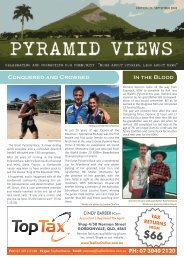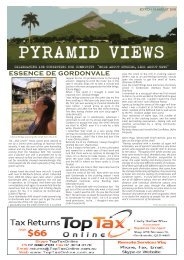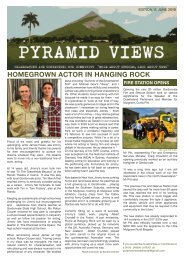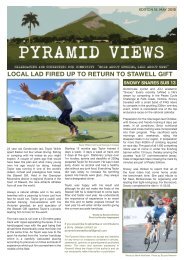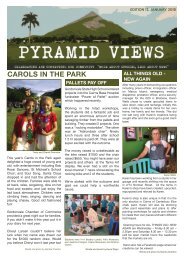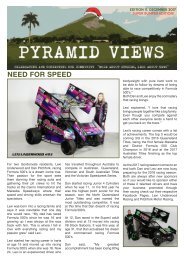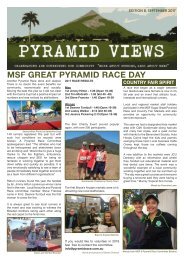Pyramid Views FEBRUARY 2018
You also want an ePaper? Increase the reach of your titles
YUMPU automatically turns print PDFs into web optimized ePapers that Google loves.
ANIMAL ANTICS<br />
With Steph Williams BVS MANZCVS<br />
NORTH QUEENSLAND EQUINE CLINIC<br />
The strange things animals ingest!<br />
Pets chewing objects up is one thing,<br />
but when pets ingest these non-food<br />
objects it can be a big problem. I thought<br />
it would be interesting to touch on just<br />
a few of the experiences I have had in<br />
dealing with animals ingesting random<br />
objects.<br />
Let’s start with the obvious, Dogs! It<br />
is a dog’s instinct to chew, and this<br />
behaviour can be amplified when a dog<br />
is a puppy, he/she is bored, or suffering<br />
anxiety (being left alone, noise phobic<br />
and so on). My own dog regularly passes<br />
bits of toys that he has decided to chew<br />
up and swallow! Unfortunately, not all<br />
objects can be passed and instead<br />
have to be manually remove from<br />
dog’s stomachs and intestines. Some<br />
common examples include corn cobs,<br />
golf balls, fish hooks, rocks, cooked<br />
bone fragments, bras, undies and even<br />
socks! Obviously, prevention is better<br />
than the cure in this instance, so keeping<br />
these objects out of reach and providing<br />
your dog with lots of SAFE alternatives<br />
to chew is essential.<br />
Most people probably don’t realise that<br />
cats can find themselves on a surgery<br />
table for foreign body removal too. Some<br />
cats, especially kittens that have been<br />
removed from their mother too soon<br />
may develop unusual sucking behaviour,<br />
whereby they suck and ingest fibres<br />
from wool blankets or even sometimes<br />
whole pieces of string. Cats tend to be<br />
better at hiding the signs of intestinal<br />
obstructions than dogs are, so it pays<br />
to identify these behaviours early and<br />
speak with your vet about how to avoid<br />
an emergency situation.<br />
I regularly get phone calls from clients<br />
who have right in front of their eyes<br />
watched their horse eat plastic bags and<br />
twine from hay bales. Some horses love<br />
mangos and while some clever horses<br />
learn to spit the seeds out, we have had<br />
to retrieve the odd mango seed from a<br />
horse’s oesophagus when he has been<br />
a bit too greedy. Ingesting chook food<br />
or dog food or even large quantities of<br />
grain after breaking into a feed shed can<br />
be life threatening for horses. Seeking<br />
veterinary advice as soon as these<br />
situations occurred is recommended.<br />
Perhaps one of the coolest cases I have<br />
seen was a tree snake who ingested a<br />
golf ball! The poor tree snake snuck into<br />
a chook nesting box, where the owner<br />
of the chooks had placed a golf ball to<br />
help encourage the chooks to lay their<br />
eggs in this spot. Apparently, to a snake,<br />
a golf ball with the scent of chicken on<br />
it, it is close enough to an egg and it will<br />
have a crack at it (pun intended).<br />
For this poor snake it could have been<br />
well over 6 months that the golf ball sat<br />
in her intestinal tract, preventing her from<br />
being able to eat anything else. She was<br />
very skinny when someone handed her<br />
in to the clinic. After rehydrating her and<br />
radiographing her we went to surgery<br />
and removed the golf ball (still in perfect<br />
condition!). She went into intensive care<br />
and was hand fed slowly before being<br />
rehabilitated and released.<br />
I could go on for ages about all the weird<br />
things animals have eaten, but I am over<br />
my word limit and when it comes to<br />
letting you know about ALL the items I<br />
have seen animals ingest, it’s probably<br />
best I keep the content PG, if you catch<br />
my drift!<br />
WHALE OF A TALE<br />
Lloyd Badger<br />
Young Lloyd Badger at 18 years of age,<br />
has scored his dream job as a crown of<br />
thorns (COTS) research diver.<br />
Looking for adventure, Lloyd applied<br />
online and progressed successfully<br />
through the interview stages then<br />
completing a rigorous 6 months of<br />
training. Lloyd’s qualifications include<br />
current Dive Master, Certificate of<br />
Business and a First Aid certificate<br />
including use of O2 and defibrillation.<br />
He would like to complete Coxswain<br />
and/or Master 5 ticket, enabling him to<br />
drive the research vessel.<br />
Lloyd’s job entails controlling COTS<br />
outbreaks, collecting live specimens<br />
for local and out of state universities;<br />
and completing reef health and impact<br />
surveys.<br />
One of Lloyd’s many highlights of the<br />
8 months he has been in the job is<br />
sighting a 6 metre whale shark on the<br />
edge of Rib Reef, 50 km off the coast<br />
of Mission Beach. This is not a common<br />
experience with Lloyd’s dive buddy on<br />
the day confirming he had never seen a<br />
whale shark in the 20 years of diving on<br />
the Great Barrier Reef.<br />
During the routine 40 minute COTS<br />
control dive, the large shadow passing<br />
over Lloyd was initially quite unnerving<br />
for him. Relief set in when Lloyd realised<br />
it was a large whale shark drifting past<br />
him at a close distance and then he was<br />
able to enjoy the experience.<br />
Page 7- PYRAMID VIEWS, <strong>FEBRUARY</strong> <strong>2018</strong> “Celebrating and connecting our community”<br />
Words by Sandra Charlton Photo by Shane Harris




